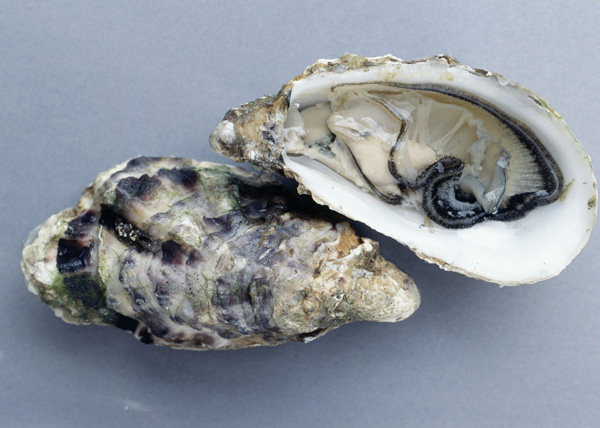As the name suggested, Oyster Shells mainly refers to the shells of Ostrea gigas Thunberg, Ostrea talienwhanensis Crosse, or Ostrea rivularis Gould. All of them are in the family Ostreidae and distributed along China’s coastal area. It can be collected all year round. And the following steps are to remove flesh, keep the shell, wash, and dry in the sun. And it is normally used crushed and raw/calcined.
Crassostrea gigas is in the shape of elongated flake, 10 to 50cm long, and 4 to 15cm wide. Dorsal seam and ventral seam are nearly parallel. Right shell is smaller and with thick scales arranged in layered or lamellar order. Lilac, white or brown outer surface is flat or with a few dents; porcelain white inner surface has no small teeth on sides of shell top. Left shell is sunken deep, and with thicker scales and small attachment surface on top. It is hard, white, odorless, slightly salty, and with layered cross sections.
Ostrea talienwhanensis is triangle and with splayed dorsiventral edges. Right shell is yellow outside and white inside and with loose wavy concentric scales. Left shell is with thick concentric scales, a couple of radial ribs from the top of the shell, recessed box-shaped inner surface, and small hinge surface.
Ostrea rivularis is round, oval, triangular, etc. Right shell is slightly uneven outside, with gray, purple, brown, yellow and other colors and concentric scales arranged in rings. Scales in young ones are thin and brittle. And they stack into layers after years of growing, with white inner surface and lavender edge in some.
OYSTER SHELL HEALTH BENEFITS
Modern medicine tends to believe that oysters contain a variety of nutrients that is necessary to the body. Clinically it is often combined with dragon bone since they has similar functions – tranquilization and liver-calming if used raw and astringency in the calcined form. More importantly, they supplement each other since oysters can also resolve hard lump while dragon bone has a better sedative action.
To better illustrate how it works, here we take its insomnia-healing property as an example. So, what is the difference between this herb and sleeping pills since both of them can help sleep disorder? To begin with, the former is a concept from traditional Chinese medicine while the latter comes from western medicine. And it doesn't make any sense to compare them; then, they act at different mechanism – the source of the former’s healing power is its heavy nature, which traditionally is believed to calm agitated heart and spirit and get rid of timidity. And sleeping pills directly act on the nerve center to help sleep; furthermore, mineral and shell drugs have a wider range of application. But sleep pill only applies to temporary insomnia caused by cute psychological stress and physical illness or sleep disorders due to severe mental illness; finally, shell drugs work slowly and steadily, with no apparent side effects or addictive qualities. It can be tailored according to the needs of the individuals. Generally it is used as an assistance drug. Sleeping pills have definite and immediate curative effect. However, it has obvious side effects like dizziness, dry mouth, stomach discomfort, etc. And long-term use would lead to drug dependence and rebound phenomenon.

Oyster Shells
SAMPLE OYSTER SHELL HERBAL REMEDIES
According to the Chinese Materia Medica, it is salty in flavor and slightly cold in nature. And it acts on the meridians of liver and kidney. Basic functions are to calm the liver and suppress yang, tranquilize with its heavy nature, soften hardness to dissipate stagnation, and induce astringency. Main oyster shells uses and indications include vertigo, Tinnitus, palpitation, Insomnia, scrofula, goiter and tumor, abdominal mass, spontaneous sweating, night sweat, emission, uterine bleeding, and abnormal vaginal discharge. Recommended dosage is from 15 to 30 grams in decoction, pills or powder. And decocting before the rest herbs is required.
1. Gui Zhi Gan Cao Long Gu Mu Li Tang from Shang Han Lun (On Cold Damage). It is combined with Gui Zhi (Ramulus Cinnamomi), Gan Cao (Licorice Root), and dragon bones to treat fidget, palpitation, insomnia, dreaminess, etc.
2. Zhen Gan Xi Feng Tang from Yi Xue Zhong Zhong Can Xi Lu (Records of Heart-Felt Experiences in Medicine with Reference to the West). It is designed with dragon bone, Gui Ban (Fresh Water Turtle Shell), Bai Shao (White Peony Root), etc., to cure dizziness, irritability, and tinnitus.
3. Da Ding Feng Zhu from Wen Bing Tiao Bian (Detailed Analysis of Warm Diseases). It is formulated with Sheng Di Huang (Rehmannia), Gui Jia (tortoise shell), Bie Jia (Soft Turtle Shell), etc. to heal burning out of yin, deficient wind agitation, and limbs twitching due to chronic febrile diseases.

![Diseases, Symptoms, tcm, [tcmwindow.com]](/uploadFile/adImg/2015/11/11/f5cbfcc0-4df5-4646-9b9a-f316651a0199.jpg)





